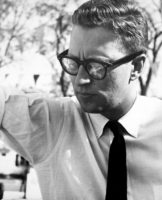Mildred Schmertz, FAIA, died January 9, 2018, at New York-Presbyterian Weill Cornell Medical Center in New York from pneumonia after suffering a fall. She was 92. Schmertz was architectural RECORD's first female editor in chief—from 1985 to 1990—and the first woman to hold that title at any American professional architectural magazine. She spent 33 years on the staff of RECORD, and during her tenure, the publication won two National Magazine Awards from the American Society of Magazine Editors, in 1972 and 1977. The second of these honors was given for a special issue on human settlements that was supervised and written by Schmertz, a senior editor at the time.
She was inducted as a Fellow of the American Institute of Architects in 1977 and served as a commissioner of New York’s Landmarks Preservation Commission from 1988 to 1991. From 1997 to 2010, Schmertz was a contributing writer for Architectural Digest, and in recent years published freelance articles for other publications such as The Architect’s Newspaper.
Schmertz was born on March 29, 1925, in Pittsburgh, the daughter of Mildred Floyd Schmertz and architect Robert Schmertz, who was also a well-known banjo folklorist and songwriter, as well as an architecture professor at Carnegie Mellon, his alma mater. Like her father, Mildred chose to study architecture at Carnegie Mellon, and after getting her B.Arch. in 1947, she worked for an architect, John Schurko, in Pittsburgh. Eight years later, she decided to explore graphic design and entered Yale University, where she earned an M.F.A. in 1957.
Schmertz’s graduate thesis proposed a graphic redesign of RECORD: soon after receiving her degree, she joined the art department of the magazine, based in New York. Given her interests and abilities, she soon moved to the editorial staff, reporting and writing a vast number of articles for RECORD. Among many other assignments, she interviewed Walter Gropius and visited Frank Lloyd Wright at Taliesin West, where she photographed the master. She covered the work of other great architects of the day—Le Corbusier, Kenzo Tange, Pier Luigi Nervi, Paul Rudolph, Marcel Breuer, I.M. Pei, Edward Larrabee Barnes, Mies van der Rohe, John Johansen—to name a few.
As senior editor, executive editor, and then editor in chief, Schmertz covered not only major architectural projects in the U.S. and Europe, but helped expand RECORD's editorial reach globally. She was an early champion of the Aga Khan Award for Architecture, for example, which honors architecture at all scales in Islamic communities around the world. Her award-winning issue on human settlements (May 1976) focused on the plight of rural populations migrating in vast numbers to cities in the developing world, with an in-depth case study of Manila, and the sponsorship of an architectural competition to plan a new community for former squatters.
During her time at the magazine, Schmertz also edited and wrote substantial portions of various record books, including Campus Planning and Design (1972) Office Building Design (1975), and New Life for Old Buildings (1982). Most recently, she was a coauthor of Mitchell/Giurgola Architects (2008). Schmertz also taught architecture writing—first as a visiting lecturer at Yale (1979), and then in the graduate program for architecture and design criticism at Parsons School of Design (1990).
As a journalist and editor, Schmertz’s mission was to present clearly and comprehensively key contemporary architectural works. Negative criticism was not her goal. She explained in an interview for RECORD's 125th anniversary in 2016, “We would simply never do what some other magazines do, or have done, and take a building that is poor or mediocre and boot it around.” As an architect, she was sympathetic to the problems her professional colleagues faced: “It sort of seemed very crude to just attack,” she said.
“Mildred was a tireless advocate for the best architecture of the moment, except for what she deemed a passing fad,” says RECORD's editor in chief Cathleen McGuigan. “She was also, until the very end, great company—a sharp observer of our world, with an even sharper wit.”
Schmertz was active in New York’s cultural community, and was the only architect to be among the first 20 women admitted to the Century Association in New York when the theretofore all-male club finally opened its doors to the opposite sex in 1988. Her cohort included Jacqueline Onassis, Beverly Sills, and Toni Morrison.
Schmertz loved biking and cross-country skiing, but architecture remained her dominant passion. “She had a voracious curiosity, whether it was about the design of a city, a building, a magazine issue, or the exquisite design of a piece of equipment in the emergency room,” said architect Deborah Taylor, a longtime friend. “She wanted those around her to appreciate the beauty of a certain product, and the sensibility of its designer.”







Post a comment to this article
Report Abusive Comment